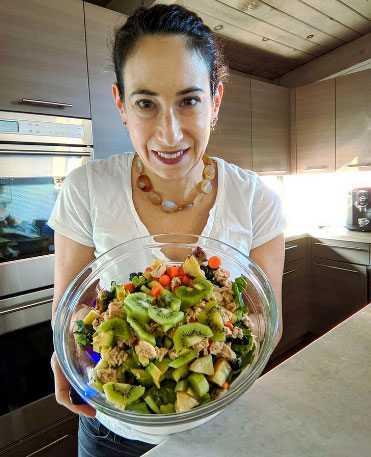Chronic inflammation is the underlying cause of many chronic diseases and conditions. It has been linked to heart disease, diabetes, cancer, and autoimmune diseases. What you eat can greatly impact inflammation in your body. Today I’m breaking down the connection between diet and inflammation and what you can start doing to use food as medicine for your inflammation.
What is inflammation and how is it triggered?
Inflammation is the process your body goes through to protect itself and bring your body back to normal otherwise known as homeostasis. There are two types of inflammation acute and chronic, both of which follow the same series of steps.
- First, a harmful substance and or damage is detected in the body.
- Second, cytokines, proteins, and enzymes or chemical mediators are released to help fight inflammation.
- Third, immune fighting white blood cells flood to the areas of damage to repair tissue and remove bacteria.
Chronic inflammation is an ongoing inflammatory process where your cells are unable to repair damaged tissue. White blood cells settle into the damaged areas and continue to produce inflammatory mediators. This creates a vicious cycle that generates more tissue damage. With chronic inflammation, your body is not able to get rid of the harmful substance or resolve the inflammatory response. So instead of going back to normal, your body continues to fight or be on the defense mode.
How does food trigger the inflammation process?
Food triggers the inflammatory process much like a virus or other foreign object that enters your body. Different foods may also trigger different reactions in the body. The most common inflammatory reactions are food allergies and food sensitivities. While there are differences in terms of the mechanism of action, they can both trigger inflammation. Allergies are not as common and are typically easier to figure out. Food sensitivities on the other hand can be really tricky.
When you eat a food that you are sensitive to your body treats that food the same way it would treat a foreign invader. The harmful substances are recognized and those chemical mediators, cytokines, proteins, and enzymes are released. Those same immune fighting white blood cells flood in and remove the food particle. However, if you don’t know you have a food sensitivity, you continue to eat that food and your body continues to have the same reaction. The inflammatory process doesn’t resolve and you start to develop chronic inflammation from that food. This can damage the surrounding tissues and cause further issues in your body.
On top of this, having a gut that is permeable or “leaky” can make you more susceptible to food sensitivities. One of the major jobs of your small intestine is to protect your body from the outside world. When your gut is leaky, those tight junctions holding your intestinal cells together loosen up this allows undigested particles, toxins, and chemicals to sneak through and enter into your Gut Associated Lymphoid Tissue (GALT). That is where a large majority of your immune cells live. And remember, these things that sneak through should not be there and your body doesn’t recognize them, so your immune cells mount an attack.
What can you do diet wise to lower your body’s inflammation?
Protecting your body from inflammation triggered by food can be solved by focusing on two specific areas, removing sensitive foods and removing foods that trigger a leaky gut.
Removing sensitive foods
- Discovering your food sensitivities can be challenging. The gold standard of practice is an elimination diet. Where you cut out all inflammatory foods to essentially calm down your immune system. Once you hit a baseline, you reintroduce foods in a very structured way in order to see which foods affect you.
- The other and more direct method is food sensitivity testing. I use a mediator release test or MRT, which looks at all chemical mediators released by food antigens. The problem with most other tests is that they only test for one component of the immune system which doesn’t really capture everything you might react to.
Removing foods that trigger leaky gut
Removing foods that trigger leaky gut is important to protect yourself from food sensitivity reactions, and to start rebuilding your gut lining. Common foods that trigger a leaky gut include gluten, dairy, alcohol, sugar, caffeine, grains, nuts and seeds. In order to be successful in figuring out what foods affect you, you must eliminate all of them at the same time and wait to see if symptoms have resolved. If they do then slowly add back foods one at a time to test your tolerance.
There is truth to what Hippocrates said thousands of years ago, let thy food be thy medicine. Food has a significant impact on your health, especially when it comes to managing chronic inflammation. If you feel like you could improve your diet to help your disease or condition please reach out and schedule a free discovery call with me. You can follow me on Instagram at @the.autoimmune.dietitian or Facebook at @annierubinnutrition or my website. Elimination diets can be very overwhelming and it’s best to work with a trained professional to make sure you’re doing it correctly.


